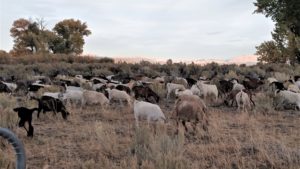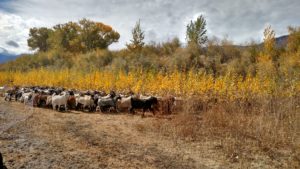 (Beyond Pesticides, August 25, 2017) While organic agriculture still represents only a fraction of the worldâs food production, organic food sales have enjoyed remarkable growth over the past couple of decades, which is captured in a recent article, Building a global platform for organic farming research, innovation and technology transfer, published by Springer online. This growth of organic is propelled by consumers and farmers who recognize significant environmental and health advantages of organic, compared to chemical-intensive agriculture. In this context, studies conclude that organic agriculture may be the best way to meet the worldâs food security and environmental needs.
(Beyond Pesticides, August 25, 2017) While organic agriculture still represents only a fraction of the worldâs food production, organic food sales have enjoyed remarkable growth over the past couple of decades, which is captured in a recent article, Building a global platform for organic farming research, innovation and technology transfer, published by Springer online. This growth of organic is propelled by consumers and farmers who recognize significant environmental and health advantages of organic, compared to chemical-intensive agriculture. In this context, studies conclude that organic agriculture may be the best way to meet the worldâs food security and environmental needs.
A bit of history for some context on this issue: for millennia, of course, all agricultural was âorganic.â Even the Industrial Revolution â which brought the combustion engine that enabled machines that made tilling, planting, and harvesting less animal-bound and human-labor intensive â had minimal impact on other aspects of how food was planted, raised, and harvested.
In the 1960s, the so-called âGreen Revolutionâ took hold, powered in part by the post-WWII technological and industrial boom in scientific and technical discoveries and applications, and in part by a rapidly growing global population that shared inequitably in the worldâs food production. This ârevolutionâ introduced and promoted intensive, largely petroleum-based and synthetic chemical inputs (primarily fertilizers and herbicides/pesticides), and genetic manipulation techniques. Although the adoption of this approach resulted in significant increases in production, it has, during its 50-year hegemony in parts of the globe, brought with it alarming levels of pollution and degradation of the natural environment, poorer soil and animal health, and increased plant vulnerability to climatic stresses, diseases, and pests.
Those are among the issues that organic agriculture successfully addresses. It improves soil health and quality; sequesters carbon; reduces erosion; increases biological activity that suppresses disease and pests, and boosts plant immunity to infection; improves cycling of nutrients in soil, making them more bioavailable to plants; and yields more healthful forage for livestock. In addition, organic yields are sometimes more stable in the face of environmental or weather stresses; and organic protocols boost populations of pollinators and beneficial insects, and lower pesticide residues.
Moving to organic agriculture seems obvious, so why isnât it happening at a faster clip? Perhaps it is because there is still disagreement about efficacy and question of feeding the world, but also, because, as discussed in the article, there are barriers to broader adoption, including technological obstacles; policies that continue to favor use of chemical inputs (fertilizers, pesticides, herbicides, and fungicides); dependency in livestock practices on petrochemical inputs and dubious animal health approaches; and an economic system in which food prices fail to reflect the environmental, health, and social costs of food production.
On the persistent question of whether organic agriculture could produce enough to feed the 7.5 billion people who inhabit the planet (and the 11.5 billion the U.N. predicts by 2100), studies have reached different conclusions. Â However, most research has focused on the question of yield.
Proponents of organic see organic yields and cost of production as competitive. âThere are actually myriad studies from around the world showing that organic farms can produce about as much [as], and in some settings, much more [than], conventional farms. Where there is a yield gap, it tends to be widest in wealthy nations, where farmers use copious amounts of synthetic fertilizers and pesticides in a perennial attempt to maximize yields.â More recent research showed organic yields in North America and Europe at 80% of conventional yields, and some studies show an even narrower gap. And notably, in the worldâs poorer countries, where food insecurity is most extreme, âthe yield gaps completely disappear.â
Assessing yield gaps between conventional and organic agriculture is a real âapples to orangesâ conundrum, not least because production varies with myriad factors, including geography, soil characteristics, weather, farm-specific practices, etc. A very large, 2015 meta-study found organic yields to be 19.2% (with a Âą3.7% margin of error) lower than conventional yields, and identified âentirely different effects of crop types and management practices on the yield gap compared with previous studies. For example, we found no significant differences in yields for leguminous versus non-leguminous crops, perennials versus annuals, or developed versus developing countries. Instead, we found the novel result that two agricultural diversification practices, multi-cropping and crop rotations, substantially reduce the yield gap (to 9 Âą 4% and 8 Âą 5%, respectively) when the methods were applied in only organic systems.â
Beyond Pesticides has long advocated for organic food and agriculture, noting that an âOrganic Green Revolution,â using integrated farming practices such as cover crops, organic no-till, and composting, can not only substantially improve yields, but also, protect and restore soil and environmental health. In 2009, Beyond Pesticides said, âOrganic agriculture can increase world food security as it offers affordable, immediately usable, and universally accessible ways to improve yields and access to nutritional food in developing countries. A 2008 report cited in a paper from the United Nation Environmental Programme (UNEP) notes that not only can organic agriculture feed the world but it may be the only way we can solve the growing problem of hunger in developing countries. UNEP states that its extensive study âchallenges the popular myth that organic agriculture cannot increase agricultural productivity.â In an analysis of 114 farming projects in 24 African countries, UNEP reports that organic or near-organic practices result in a yield increase of more than 100 percent.â
In 2009, Beyond Pesticides reported on a 2008 Rodale Institute research paper, titled The Organic Green Revolution, including a review of replicated research, shows that the latest scientific approaches in organic agriculture offer affordable, immediately usable, and universally accessible ways to improve yields and access to nutritional food in developing countries.
Some have predicted catastrophe should the world convert to organic farming. At a 2002 conference, award-winning plant breeder Norman Borlaug said, âWe aren’t going to feed 6 billion people with organic fertilizer. If we tried to do it, we would level most of our forest and many of those lands would be productive only for a short period of time.â Cambridge University chemist John Emsley pulled no punches in his assessment: âThe greatest catastrophe that the human race could face this century is not global warming but a global conversion to âorganic farming’ â an estimated 2 billion people would perish.â Still others believe that organic agriculture is an inefficient approach to food security. (For a primer on the question, see this Worldwatch Institute article.]
Despite the different perspectives, the impetus for organic growth is driven by a desire to address the multiple environmental and health problems that humanity faces. Still, challenges and obstacles to the advancement of organic abound.
IFOAMâOrganics International, a consortium of 800 organizations across 100 countries â an umbrella of sorts for the organics movement â is acting on those challenges. In 2013 it formed its Technology Innovation Platform (TIPI) to advance organic farming through research, development, innovation, and technology transfer. By engaging stakeholders, including researchers, farmers, consumers, and all those along the âvalue chainâ of food systems, it hopes to develop an agenda for advancing organic production and to advocate for funding initiatives that do so.
IFOAM notes that the kind of research and investment that can help organic farming practices grow and improve is currently insufficient to the task. In recent years, such investment has increased, but it is still a pittance compared to conventional/industrial agricultureâs spending on agrochemicals, genetic engineering, CAFOs (confined animal farming operations), and other approaches that organic practices disallow. Global investment in âorganic supportiveâ research and development activity [as of 2011] was .5% of the total investment in agricultural R&D. During the past couple of decades, especially, there has been an overall decline in public funding of ag research, and a concomitant rise in the rate of corporate investment in proprietary biotechnology (think, e.g., of Monsanto and its dominance in GE soybean seeds in the U.S. because of its development of the glyphosate herbicide, Roundup). IFOAM also points out that âagroecological research seen as compatible with organic farming systems does not provide the same incentives for private sector investment in research and development because their benefits are long-term and are public goods.â
TIPI has identified three strategic research approaches for the sector: (1) develop research methods appropriate for organic food and farming systems; (2) renew partnerships between farmers, farm advisors, scientists, and consumers; and (3) integrate technological, social, and ecological dimensions of innovation. It also advocates for three âpathways,â or goals, for the advancement of organics: (1) organic agriculture becomes the preferred land use system in rural areas worldwide; (2) food and ecosystem security are attained through eco-functional intensification; and (3) organic agriculture produces healthful food in an equitable manner for the well-being of everyone. (See details on these strategies and their research implications in Table 2, here.)
A sampling of TIPIâs goals for enactment of those strategies includes: develop value-added food chains in rural economies; use local sourcing and processing; establish a norm of human, animal, soil, and plant health as primary axes of investigation; breed crops and livestock better suited to local conditions; design ag systems to enhance biodiversity; increase sustainable yields via use of polycultures, variety selection, improved crop rotation, and improved nutrient recycling; investigate relationships between organic food quality and human health; improve technologies to recover organic wastes and return them to the soil; examine and adapt traditional food processing to modern techniques to improve performance and quality of authentic, heritage foods; investigate ways to prevent contamination by pesticides, genetically modified organisms, and other contaminants in production and handling.
Organic agriculture can respond to our human and environmental sustainability needs, but it needs support from all corners. Beyond Pesticides advocates choosing local, organic goods whenever possible; see our Organic Agriculture pages for more information. As Paul Ehrlich and Lauren Ponisio point out, âThe sustainability of society hinges on the future of agriculture.â
Source: Building a Global Platform for Organic Farming Research, Innovation and Technology Transfer
 new research published by scientists at Washington State University. This burgeoning area of study on âtransgenerationalâ impacts calls into question the current methodology for assessing toxicity and risk from chemical exposure. With the current U.S. regulatory system permitting food and communities to be awash in toxic pesticides, the results of the study have grave implications for future generations.
new research published by scientists at Washington State University. This burgeoning area of study on âtransgenerationalâ impacts calls into question the current methodology for assessing toxicity and risk from chemical exposure. With the current U.S. regulatory system permitting food and communities to be awash in toxic pesticides, the results of the study have grave implications for future generations.








 feasibility of electronic disclosures as a means of providing consumers with information on genetically engineered (GE) food ingredients. The study, which should have been published in July 2017 by law, confirms concerns held by many that âelectronic and digital disclosuresâ (QR codes) will pose technological challenges for consumers, limiting access to food information. The study was required by the 2016 Federal Bioengineered Food Disclosure Standards Act (the â
feasibility of electronic disclosures as a means of providing consumers with information on genetically engineered (GE) food ingredients. The study, which should have been published in July 2017 by law, confirms concerns held by many that âelectronic and digital disclosuresâ (QR codes) will pose technological challenges for consumers, limiting access to food information. The study was required by the 2016 Federal Bioengineered Food Disclosure Standards Act (the â controversy is coming to a head on allowing hydroponics to be certified organic. Contrary to prior recommendations of the NOSB, the National Organic Program has allowed some hydroponics operations to be certified. The NOSB will consider motions at this meeting that could stop this practice.
controversy is coming to a head on allowing hydroponics to be certified organic. Contrary to prior recommendations of the NOSB, the National Organic Program has allowed some hydroponics operations to be certified. The NOSB will consider motions at this meeting that could stop this practice. program, led by the Washoe Tribal Environmental Protection Department (WEPD), is being conducted with the Washington, DC-based organization Beyond Pesticides and Goat Green LLC., a goat grazing company based in Wyoming.
program, led by the Washoe Tribal Environmental Protection Department (WEPD), is being conducted with the Washington, DC-based organization Beyond Pesticides and Goat Green LLC., a goat grazing company based in Wyoming.
 Department of Pesticide Regulation (DPR) decision to approve additional uses for two bee-killing pesticides without disclosing the impact on honeybees.
Department of Pesticide Regulation (DPR) decision to approve additional uses for two bee-killing pesticides without disclosing the impact on honeybees. reaching its conclusion that glyphosate (Roundup) is âunlikely to pose a carcinogenic hazard to humans,â according to recent report in
reaching its conclusion that glyphosate (Roundup) is âunlikely to pose a carcinogenic hazard to humans,â according to recent report in  soil on conventional chemical-intensive farms, according to a study conducted by researchers from Northeastern University and The Organic Center. The continuing effects of climate change necessitate a robust approach to both limiting and reducing carbon in the earthâs atmosphere. As the study shows, a wholesale transition from conventional to organic farming could play an important part in mitigating the effects of a warming planet.
soil on conventional chemical-intensive farms, according to a study conducted by researchers from Northeastern University and The Organic Center. The continuing effects of climate change necessitate a robust approach to both limiting and reducing carbon in the earthâs atmosphere. As the study shows, a wholesale transition from conventional to organic farming could play an important part in mitigating the effects of a warming planet. âsince the administrator of EPA refused to take the action agency scientists said is necessary to protect children.
âsince the administrator of EPA refused to take the action agency scientists said is necessary to protect children. according to reports from
according to reports from  autism spectrum disorder (ASD) even when their mothers were exposed to household or agricultural pesticides. Researchers at the University of California, Davis found that taking folic acid during the window around conception, reduced the risk of pesticide-induced autism.
autism spectrum disorder (ASD) even when their mothers were exposed to household or agricultural pesticides. Researchers at the University of California, Davis found that taking folic acid during the window around conception, reduced the risk of pesticide-induced autism. from western North America have declined far more dramatically than was previously known and face a greater risk of extinction â 86 percent in the next 50 years. The researchers do not know the exact cause but identify habitat loss and widespread pesticide use as likely culprits.
from western North America have declined far more dramatically than was previously known and face a greater risk of extinction â 86 percent in the next 50 years. The researchers do not know the exact cause but identify habitat loss and widespread pesticide use as likely culprits. exposed to 123 pesticide residues in their daily lunches. The results call attention to the health and safety implications of pesticide exposure to children, which have developing body systems more sensitive to pesticide exposure. PAN-UK and other health groups are calling for a wholesale changeover to serving onlyorganic fruits and vegetables in schools.
exposed to 123 pesticide residues in their daily lunches. The results call attention to the health and safety implications of pesticide exposure to children, which have developing body systems more sensitive to pesticide exposure. PAN-UK and other health groups are calling for a wholesale changeover to serving onlyorganic fruits and vegetables in schools. The ice cream brand says its social mission âseeks to meet human needs and eliminate the injustices in our local, national and international communities,â and that its focus is âon children and families, the environment and sustainable agriculture on family farms.â
The ice cream brand says its social mission âseeks to meet human needs and eliminate the injustices in our local, national and international communities,â and that its focus is âon children and families, the environment and sustainable agriculture on family farms.â Wetlands improve water quality, sequester carbon, remove or neutralize pollutants, control flooding, protect adjacent areas from erosion, and host a multitude of beneficial plant and animal species â not to mention their recreational and aesthetic value.As recently reported inÂ
Wetlands improve water quality, sequester carbon, remove or neutralize pollutants, control flooding, protect adjacent areas from erosion, and host a multitude of beneficial plant and animal species â not to mention their recreational and aesthetic value.As recently reported in  genetically engineered (GE) food,
genetically engineered (GE) food,  demographic groups, including those in farming. People working in the transportation sector registered the highest incidence of diagnosed diabetes at 10.6%. But those working as farmers and fishermen came in second, with 8.5% reporting a diagnosis of the disease.
demographic groups, including those in farming. People working in the transportation sector registered the highest incidence of diagnosed diabetes at 10.6%. But those working as farmers and fishermen came in second, with 8.5% reporting a diagnosis of the disease. (Beyond Pesticides, September 5, 2017) The bog copper butterfly (Lycaena epixante) is a member of the second largest family of butterflies, Lycaenidae, which includes over 4,700 species worldwide. Also known as the cranberry-bog copper butterfly, the species has strong biological ties to cranberry plants and its associated habitat.
(Beyond Pesticides, September 5, 2017) The bog copper butterfly (Lycaena epixante) is a member of the second largest family of butterflies, Lycaenidae, which includes over 4,700 species worldwide. Also known as the cranberry-bog copper butterfly, the species has strong biological ties to cranberry plants and its associated habitat. (Beyond Pesticides, September 1, 2017)Â
(Beyond Pesticides, September 1, 2017)  agricultural areas increases the risk of giving birth to a baby with abnormalities. These results are more significant for those exposed to very high levels of pesticides, underscoring the continued risks faced by farmworkers and farmworker families, especially mothers living near chemically-intensive treated fields.
agricultural areas increases the risk of giving birth to a baby with abnormalities. These results are more significant for those exposed to very high levels of pesticides, underscoring the continued risks faced by farmworkers and farmworker families, especially mothers living near chemically-intensive treated fields. pesticides from the market, according to a study recently published by
pesticides from the market, according to a study recently published by  Environmental Protection Agency (EPA) for pregnant women. Chlorpyrifos is linked to low IQs, autism and other developmental neurological effects. Earlier this year, EPA Administrator Scott Pruitt refused to ban chlorpyrifos to the dismay of many scientists, medical professionals, and farmworker organizations.
Environmental Protection Agency (EPA) for pregnant women. Chlorpyrifos is linked to low IQs, autism and other developmental neurological effects. Earlier this year, EPA Administrator Scott Pruitt refused to ban chlorpyrifos to the dismay of many scientists, medical professionals, and farmworker organizations. (Beyond Pesticides, August 28, 2017)Â School policies must protect children from pesticides by adopting organic land and building management policies and serving organic food in cafeterias. At the start of the school year, it is critical for school administrators to make sure that students and teachers are learning and teaching in an environment where no hazardous pesticides are used in the schoolâs buildings or on playing fields. It is also essential that children have access to organic food in food programs and manage school gardens organically.
(Beyond Pesticides, August 28, 2017)Â School policies must protect children from pesticides by adopting organic land and building management policies and serving organic food in cafeterias. At the start of the school year, it is critical for school administrators to make sure that students and teachers are learning and teaching in an environment where no hazardous pesticides are used in the schoolâs buildings or on playing fields. It is also essential that children have access to organic food in food programs and manage school gardens organically. (Beyond Pesticides, August 25, 2017) While organic agriculture still represents only a fraction of the worldâs food production, organic food sales have enjoyed remarkable growth over the past couple of decades, which is captured in a recent article,
(Beyond Pesticides, August 25, 2017) While organic agriculture still represents only a fraction of the worldâs food production, organic food sales have enjoyed remarkable growth over the past couple of decades, which is captured in a recent article, 
